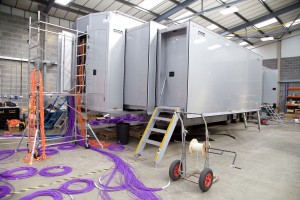Timeline and SAM discuss IP infrastructure of forthcoming UHD2 truck
The next futuristic OB truck to join the extensive fleet of Timeline Television is due to be road-ready by 1 May. Ahead of the launch of this ambitious new vehicle, Timeline Managing Director Daniel McDonnell and Snell Sales Director, Northern Europe & Africa, Mark Gardner sat down with SVG Europe at BVE 2017 to preview UHD2’s comprehensive IP infrastructure and UHD and HDR capabilities.
It is only a matter of weeks since Timeline rolled out its new compact UHD uplinks truck (https://www.svgeurope.org/blog/headlines/timeline-television-rolls-out-compact-new-uhd-truck-for-bt-sport/), RF1, so what was the starting point for UHD2?
McDonnell: When we started on this project we knew that we wanted to build a large OB truck and set our goals as being 4K and the ability to work with HDR and SDR, and accommodate 32 cabled cameras. Now whilst it is just about possible to [achieve this] with quad SDI, you can really hit the limits of what you can do and so we began to look seriously into an IP-based solution – and ended up working with SAM for about a year to see how it could be implemented. [Fortuitously, the new SAM IP cards] arrived at the right time for us to be able to put in a complete IP infrastructure.
At the time of our conversation we are about to take delivery of the metalwork [frame] from Smiths and will then start on the integration in-house at our Greenford facilities [in Ealing, West London]. We expect that the truck will be ready to roll on 1 May.
Mark, what do you observe about this project from a SAM perspective?
Gardner: The first thing to say is that we have had a very close relationship with Timeline for a number of years now, including on the first UHD truck that they built, which was in progress when [SAM switcher] Kahuna was becoming a popular choice for UHD. [With this new truck] we felt that the IP solution was ready to handle the full, UHD, uncompressed type of application, and Timeline had a chassis coming along that this fitted into nicely…
So as a result this will be our first installation where they are using IP cards for 4K through a core. And whilst we have done tests [with HDR] before, this will be our first proper HDR-capable truck.
Dan, can you tell us a little bit more about the unique features of UHD2?
McDonnell: The other big differentiator is that we will be working in TR-03 or a split environment, so it will be possible to work with video and audio as separate entities within the IP world. The current way of working in IP is that if you select video you get the audio that comes with it. But the SAM technology allows the audio and video [to be processed separately] then be joined together at the endpoint, whether that be an EVS server, Sony recorder, or an embedder.
With regard to the design of the new truck, how much of it is a reflection of current requirements, and how much a projection of future needs?
McDonnell: I think that one of the most important elements is the 100GB backbone and I think that in two years people will definitely be building [their workflows around that]. For example, it gives you the ability to manage the audio totally flexibly, so the truck is really ahead of the curve, I think.
One of the main selling points is that we have two Kahunas so we can run SDR and HDR simultaneously. So if you want to do music or arts events with HDR – and those are good markets for it – you can do that whilst maintaining a 4K and HDR layer that is totally unaffected.
We expect 10GB to become a legacy format over the next few years as companies [find it more cost-effective] to put 100GB infrastucture into data centres; 100GB is ten times as powerful as 10GB, but is not ten times the cost.
And even with the capability this truck has in its current form, there is still tremendous expansion possibility for the future…
McDonnell: Absolutely. Some people have asked me why we are building in IP when it is possible to do a large-scale OB in quad SDI. But as I said you are very much hitting the edge stop of your matrix size, whereas with IP if we want to add another multiviewer or a porta-cabin with 200 screens, we can do that instantly.
There are lots of different ways of looking at IP, and in a way [I think the industry] is only just beginning to realise its potential. Every day I learn something new!
Gardner: One other element that I would highlight is the part of the solution that acts above the IP layer and extracts a certain amount of complexity around the multiviewer addresses. Also there will be great familiarity for those using the truck. Axon Cerebrum will be the user interface, so whether we are talking about EVS operators, directors or producers, the IP truck will appear the same operationally as its predecessors.

